Liejun Wang
Boosting Active Defense Persistence: A Two-Stage Defense Framework Combining Interruption and Poisoning Against Deepfake
Aug 11, 2025Abstract:Active defense strategies have been developed to counter the threat of deepfake technology. However, a primary challenge is their lack of persistence, as their effectiveness is often short-lived. Attackers can bypass these defenses by simply collecting protected samples and retraining their models. This means that static defenses inevitably fail when attackers retrain their models, which severely limits practical use. We argue that an effective defense not only distorts forged content but also blocks the model's ability to adapt, which occurs when attackers retrain their models on protected images. To achieve this, we propose an innovative Two-Stage Defense Framework (TSDF). Benefiting from the intensity separation mechanism designed in this paper, the framework uses dual-function adversarial perturbations to perform two roles. First, it can directly distort the forged results. Second, it acts as a poisoning vehicle that disrupts the data preparation process essential for an attacker's retraining pipeline. By poisoning the data source, TSDF aims to prevent the attacker's model from adapting to the defensive perturbations, thus ensuring the defense remains effective long-term. Comprehensive experiments show that the performance of traditional interruption methods degrades sharply when it is subjected to adversarial retraining. However, our framework shows a strong dual defense capability, which can improve the persistence of active defense. Our code will be available at https://github.com/vpsg-research/TSDF.
Bridging Semantic Logic Gaps: A Cognition-Inspired Multimodal Boundary-Preserving Network for Image Manipulation Localization
Aug 10, 2025Abstract:The existing image manipulation localization (IML) models mainly relies on visual cues, but ignores the semantic logical relationships between content features. In fact, the content semantics conveyed by real images often conform to human cognitive laws. However, image manipulation technology usually destroys the internal relationship between content features, thus leaving semantic clues for IML. In this paper, we propose a cognition-inspired multimodal boundary-preserving network (CMB-Net). Specifically, CMB-Net utilizes large language models (LLMs) to analyze manipulated regions within images and generate prompt-based textual information to compensate for the lack of semantic relationships in the visual information. Considering that the erroneous texts induced by hallucination from LLMs will damage the accuracy of IML, we propose an image-text central ambiguity module (ITCAM). It assigns weights to the text features by quantifying the ambiguity between text and image features, thereby ensuring the beneficial impact of textual information. We also propose an image-text interaction module (ITIM) that aligns visual and text features using a correlation matrix for fine-grained interaction. Finally, inspired by invertible neural networks, we propose a restoration edge decoder (RED) that mutually generates input and output features to preserve boundary information in manipulated regions without loss. Extensive experiments show that CMB-Net outperforms most existing IML models.
Beyond Fully Supervised Pixel Annotations: Scribble-Driven Weakly-Supervised Framework for Image Manipulation Localization
Jul 17, 2025Abstract:Deep learning-based image manipulation localization (IML) methods have achieved remarkable performance in recent years, but typically rely on large-scale pixel-level annotated datasets. To address the challenge of acquiring high-quality annotations, some recent weakly supervised methods utilize image-level labels to segment manipulated regions. However, the performance is still limited due to insufficient supervision signals. In this study, we explore a form of weak supervision that improves the annotation efficiency and detection performance, namely scribble annotation supervision. We re-annotated mainstream IML datasets with scribble labels and propose the first scribble-based IML (Sc-IML) dataset. Additionally, we propose the first scribble-based weakly supervised IML framework. Specifically, we employ self-supervised training with a structural consistency loss to encourage the model to produce consistent predictions under multi-scale and augmented inputs. In addition, we propose a prior-aware feature modulation module (PFMM) that adaptively integrates prior information from both manipulated and authentic regions for dynamic feature adjustment, further enhancing feature discriminability and prediction consistency in complex scenes. We also propose a gated adaptive fusion module (GAFM) that utilizes gating mechanisms to regulate information flow during feature fusion, guiding the model toward emphasizing potential tampered regions. Finally, we propose a confidence-aware entropy minimization loss (${\mathcal{L}}_{ {CEM }}$). This loss dynamically regularizes predictions in weakly annotated or unlabeled regions based on model uncertainty, effectively suppressing unreliable predictions. Experimental results show that our method outperforms existing fully supervised approaches in terms of average performance both in-distribution and out-of-distribution.
DiffMark: Diffusion-based Robust Watermark Against Deepfakes
Jul 02, 2025Abstract:Deepfakes pose significant security and privacy threats through malicious facial manipulations. While robust watermarking can aid in authenticity verification and source tracking, existing methods often lack the sufficient robustness against Deepfake manipulations. Diffusion models have demonstrated remarkable performance in image generation, enabling the seamless fusion of watermark with image during generation. In this study, we propose a novel robust watermarking framework based on diffusion model, called DiffMark. By modifying the training and sampling scheme, we take the facial image and watermark as conditions to guide the diffusion model to progressively denoise and generate corresponding watermarked image. In the construction of facial condition, we weight the facial image by a timestep-dependent factor that gradually reduces the guidance intensity with the decrease of noise, thus better adapting to the sampling process of diffusion model. To achieve the fusion of watermark condition, we introduce a cross information fusion (CIF) module that leverages a learnable embedding table to adaptively extract watermark features and integrates them with image features via cross-attention. To enhance the robustness of the watermark against Deepfake manipulations, we integrate a frozen autoencoder during training phase to simulate Deepfake manipulations. Additionally, we introduce Deepfake-resistant guidance that employs specific Deepfake model to adversarially guide the diffusion sampling process to generate more robust watermarked images. Experimental results demonstrate the effectiveness of the proposed DiffMark on typical Deepfakes. Our code will be available at https://github.com/vpsg-research/DiffMark.
WaveGuard: Robust Deepfake Detection and Source Tracing via Dual-Tree Complex Wavelet and Graph Neural Networks
May 14, 2025Abstract:Deepfake technology poses increasing risks such as privacy invasion and identity theft. To address these threats, we propose WaveGuard, a proactive watermarking framework that enhances robustness and imperceptibility via frequency-domain embedding and graph-based structural consistency. Specifically, we embed watermarks into high-frequency sub-bands using Dual-Tree Complex Wavelet Transform (DT-CWT) and employ a Structural Consistency Graph Neural Network (SC-GNN) to preserve visual quality. We also design an attention module to refine embedding precision. Experimental results on face swap and reenactment tasks demonstrate that WaveGuard outperforms state-of-the-art methods in both robustness and visual quality. Code is available at https://github.com/vpsg-research/WaveGuard.
AMNet: An Acoustic Model Network for Enhanced Mandarin Speech Synthesis
Apr 12, 2025Abstract:This paper presents AMNet, an Acoustic Model Network designed to improve the performance of Mandarin speech synthesis by incorporating phrase structure annotation and local convolution modules. AMNet builds upon the FastSpeech 2 architecture while addressing the challenge of local context modeling, which is crucial for capturing intricate speech features such as pauses, stress, and intonation. By embedding a phrase structure parser into the model and introducing a local convolution module, AMNet enhances the model's sensitivity to local information. Additionally, AMNet decouples tonal characteristics from phonemes, providing explicit guidance for tone modeling, which improves tone accuracy and pronunciation. Experimental results demonstrate that AMNet outperforms baseline models in subjective and objective evaluations. The proposed model achieves superior Mean Opinion Scores (MOS), lower Mel Cepstral Distortion (MCD), and improved fundamental frequency fitting $F0 (R^2)$, confirming its ability to generate high-quality, natural, and expressive Mandarin speech.
Leveraging Label Potential for Enhanced Multimodal Emotion Recognition
Apr 07, 2025Abstract:Multimodal emotion recognition (MER) seeks to integrate various modalities to predict emotional states accurately. However, most current research focuses solely on the fusion of audio and text features, overlooking the valuable information in emotion labels. This oversight could potentially hinder the performance of existing methods, as emotion labels harbor rich, insightful information that could significantly aid MER. We introduce a novel model called Label Signal-Guided Multimodal Emotion Recognition (LSGMER) to overcome this limitation. This model aims to fully harness the power of emotion label information to boost the classification accuracy and stability of MER. Specifically, LSGMER employs a Label Signal Enhancement module that optimizes the representation of modality features by interacting with audio and text features through label embeddings, enabling it to capture the nuances of emotions precisely. Furthermore, we propose a Joint Objective Optimization(JOO) approach to enhance classification accuracy by introducing the Attribution-Prediction Consistency Constraint (APC), which strengthens the alignment between fused features and emotion categories. Extensive experiments conducted on the IEMOCAP and MELD datasets have demonstrated the effectiveness of our proposed LSGMER model.
Magnitude-Phase Dual-Path Speech Enhancement Network based on Self-Supervised Embedding and Perceptual Contrast Stretch Boosting
Mar 27, 2025Abstract:Speech self-supervised learning (SSL) has made great progress in various speech processing tasks, but there is still room for improvement in speech enhancement (SE). This paper presents BSP-MPNet, a dual-path framework that combines self-supervised features with magnitude-phase information for SE. The approach starts by applying the perceptual contrast stretching (PCS) algorithm to enhance the magnitude-phase spectrum. A magnitude-phase 2D coarse (MP-2DC) encoder then extracts coarse features from the enhanced spectrum. Next, a feature-separating self-supervised learning (FS-SSL) model generates self-supervised embeddings for the magnitude and phase components separately. These embeddings are fused to create cross-domain feature representations. Finally, two parallel RNN-enhanced multi-attention (REMA) mask decoders refine the features, apply them to the mask, and reconstruct the speech signal. We evaluate BSP-MPNet on the VoiceBank+DEMAND and WHAMR! datasets. Experimental results show that BSP-MPNet outperforms existing methods under various noise conditions, providing new directions for self-supervised speech enhancement research. The implementation of the BSP-MPNet code is available online\footnote[2]{https://github.com/AlimMat/BSP-MPNet. \label{s1}}
Modality-Invariant Bidirectional Temporal Representation Distillation Network for Missing Multimodal Sentiment Analysis
Jan 07, 2025
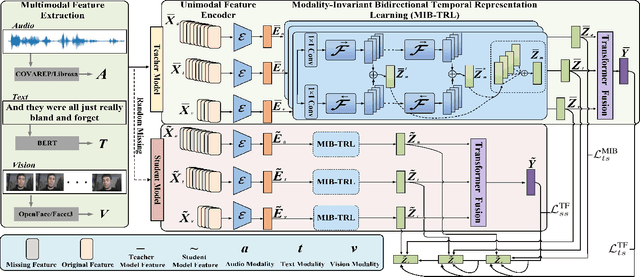
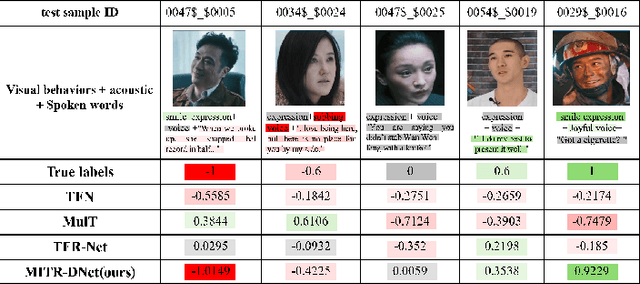
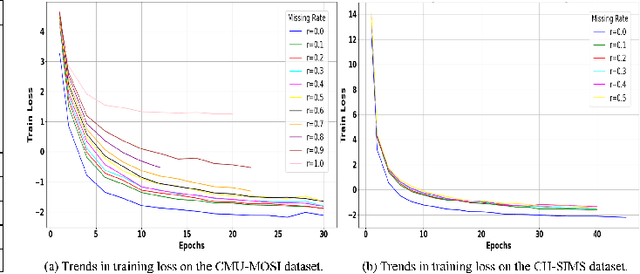
Abstract:Multimodal Sentiment Analysis (MSA) integrates diverse modalities(text, audio, and video) to comprehensively analyze and understand individuals' emotional states. However, the real-world prevalence of incomplete data poses significant challenges to MSA, mainly due to the randomness of modality missing. Moreover, the heterogeneity issue in multimodal data has yet to be effectively addressed. To tackle these challenges, we introduce the Modality-Invariant Bidirectional Temporal Representation Distillation Network (MITR-DNet) for Missing Multimodal Sentiment Analysis. MITR-DNet employs a distillation approach, wherein a complete modality teacher model guides a missing modality student model, ensuring robustness in the presence of modality missing. Simultaneously, we developed the Modality-Invariant Bidirectional Temporal Representation Learning Module (MIB-TRL) to mitigate heterogeneity.
One Small and One Large for Document-level Event Argument Extraction
Nov 08, 2024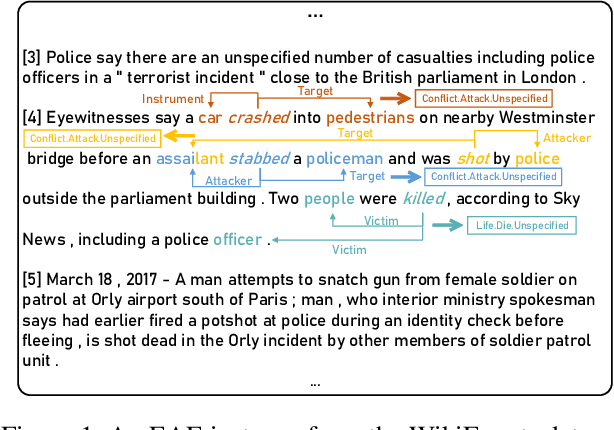

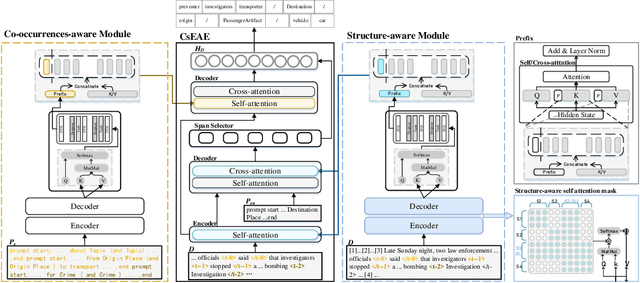
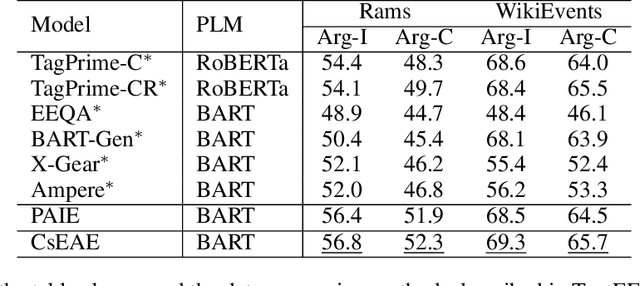
Abstract:Document-level Event Argument Extraction (EAE) faces two challenges due to increased input length: 1) difficulty in distinguishing semantic boundaries between events, and 2) interference from redundant information. To address these issues, we propose two methods. The first method introduces the Co and Structure Event Argument Extraction model (CsEAE) based on Small Language Models (SLMs). CsEAE includes a co-occurrences-aware module, which integrates information about all events present in the current input through context labeling and co-occurrences event prompts extraction. Additionally, CsEAE includes a structure-aware module that reduces interference from redundant information by establishing structural relationships between the sentence containing the trigger and other sentences in the document. The second method introduces new prompts to transform the extraction task into a generative task suitable for Large Language Models (LLMs), addressing gaps in EAE performance using LLMs under Supervised Fine-Tuning (SFT) conditions. We also fine-tuned multiple datasets to develop an LLM that performs better across most datasets. Finally, we applied insights from CsEAE to LLMs, achieving further performance improvements. This suggests that reliable insights validated on SLMs are also applicable to LLMs. We tested our models on the Rams, WikiEvents, and MLEE datasets. The CsEAE model achieved improvements of 2.1\%, 2.3\%, and 3.2\% in the Arg-C F1 metric compared to the baseline, PAIE~\cite{PAIE}. For LLMs, we demonstrated that their performance on document-level datasets is comparable to that of SLMs~\footnote{All code is available at https://github.com/simon-p-j-r/CsEAE}.
 Add to Chrome
Add to Chrome Add to Firefox
Add to Firefox Add to Edge
Add to Edge